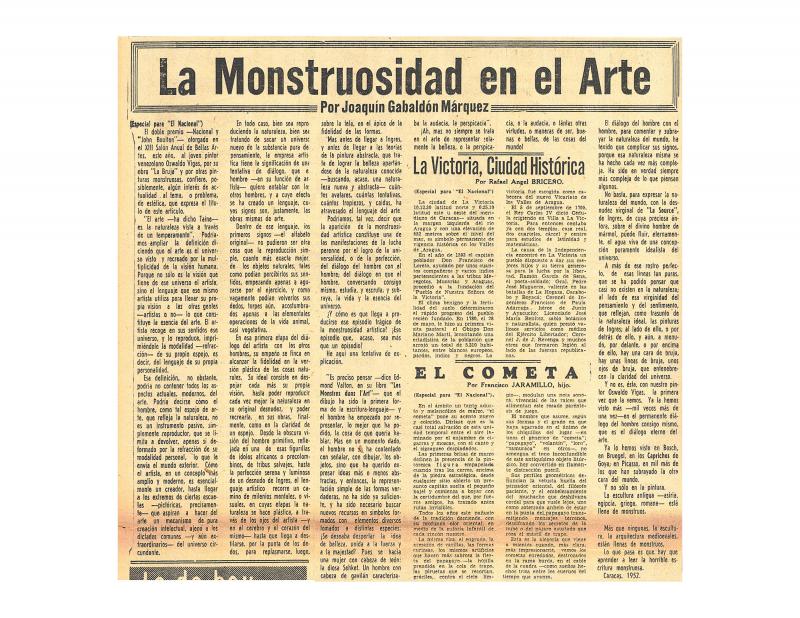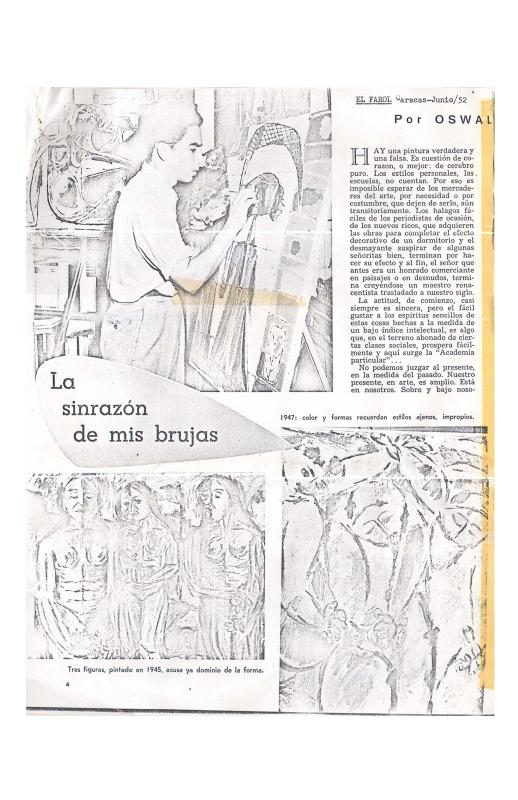This interview by M. C. with the Venezuelan painter Oswaldo Vigas (b. 1926) was conducted in the context of the opening of the artist’s individual exhibition Ídolos y personajes (Caracas: Galería Durban, 1984). At the time, the artist was returning to the Venezuelan visual art scene with an approach true to his thematic influences, introducing variations in his creative resources. The interview highlights Vigas’s opinion about the idea of the “search” in art, which led to responses such as that of Manuel Quintana Castillo. Vigas rejects the performance of the search, which he regards as a process that belongs to the field of the sciences. In his opinion, the artwork is the product of accidental discoveries or the result of the artist’s own development of the work, but not the result of any systematic search. In some way, his statements refer to art trends linked to technology and scientific progress, as opposed to art languages with roots in the past and organic experiences. On the other hand, his positive assessment of Venezuela’s visual art scene at the time reflects “the revival” of Venezuelan painting during the 1980s. It was a decade in which painting was coming back as a predominant medium, leading the way toward new discourses. Similarly, this article relates the painter’s story about a diplomatic incident that occurred during the 31st Biennale di Venezia (1962), in which Vigas served as part of the Curatorial Committee. During that biennial, in the course of a performance, the artist Francisco Valero la Cruz threw a sack of rats at the president of Italy. [Though other witnesses stated that the performer was the Argentinean Conceptual artist Alberto Greco, with one of his designs of “arte vivo-dito,” that is, art vitalized by pointing with the finger]. Vigas uses this story to raise the possibility that such “search” processes driven by the desire for recognition may lead young artists to make questionable, sensational artistic choices. In the artist’s opinion, such expressions may not even have any content beyond that of scandal. As someone who already wrote a couple of texts on the artist, Montero Castro is a likely possibility for the interviewer whose initials are “MC.” Regarding the work of Oswaldo Vigas, see the following texts in the ICAA digital archive: by Juan Liscano “La reiteración de Vigas” (doc. no. 1152769); two by Roberto Montero Castro, “Vigas en el ojo ajeno - Plástica e identidad latinoamericana” (doc. no. 1153266) and “Oswaldo Vigas : La lucha por descubrir la identidad americana” (doc. no. 1168108); the text by Joaquin Gabaldón “La monstruosidad en el arte” (doc. no. 850831); the article by Lenelina Delgado “De la pintura al tapiz” (doc. no. 1153365); and one by A. Feltra “Vigas sufre de afán publicitario” (doc. no. 1155580). In addition, see Carlos Silva’s essay “Vigas o la lucidez” (doc. no. 1153397); and Paco Benmaman’s interview “Oswaldo Vigas explosivo: Antes las brujas, ahora las bombas” (doc. no. 1153245). There are other texts in which Vigas analyzes this theme: see the ICAA digital archive, “La sin razón de mis brujas,” (doc. no. 1153349) and “Lo que se tiene no se busca” (doc. no. 1152785)].










